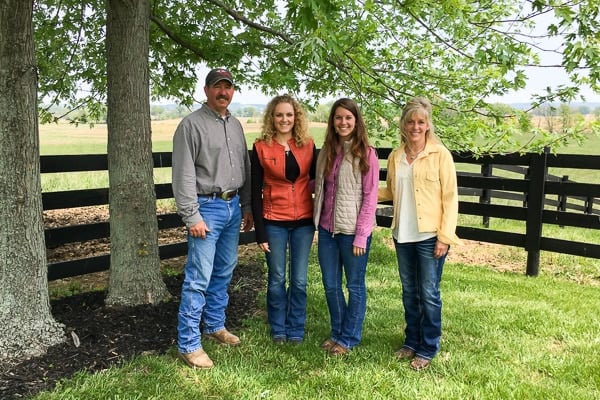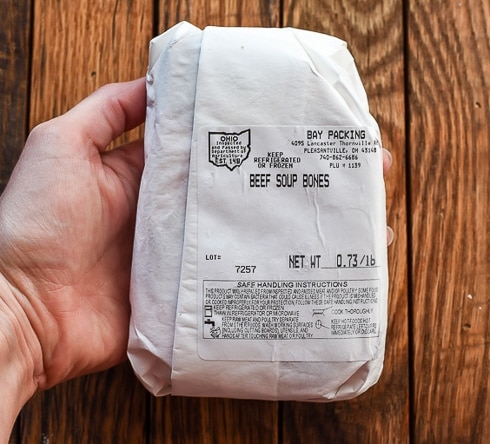Whatdo I Need to Know About Buying a Whole Beef
Each year for the last four years, our family has purchased a quarter or half side of beef from a local farmer to fill our freezer. There are so many advantages to buying beef this way, but I know it's not always easy to figure out how to source, buy, store, and use that much beef. In this post, I hope to provide some helpful guidance and answer common questions so you can feel confident buying a side of beef for your family.

Is Buying a Side of Beef Right for Me?
I believe anyone can benefit from buying a side of beef, but there are a few factors to consider before you start the process. First, do you have the space to store the beef? In my experience, a deep freezer is necessary for this purchase. I'll go into further detail about the amount of beef you can expect to receive later in the post, but I recommend planning for 175-200 lbs. of take home beef in a side, and 80-100 lbs for a quarter.
Secondly, can you afford the up front investment of buying a side of beef? To be sure, buying beef in bulk can save you a lot of money in the long run (more on that later), but it definitely requires a substantial up front investment.
Of course, if you don't have the freezer space or upfront investment available, you can still benefit from buying beef in bulk. I definitely recommend rounding up a few friends to purchase a side together. You'll have to divvy up the meat yourselves, but you'll still get all the benefits of buying locally, saving money, and having some leftover freezer space for those very necessary ice cream sandwiches. 🙂

How the Process Works
So you're ready to buy a side of beef! Wahoo! Here's how the process usually works.
- Research and call a few different farmers, and decide on one who fits your values and budget. The farmer will let you know when their next sides will be available for butchering.
- When cattle are ready for market, it will be taken to a processor or butcher to be harvested and processed into the cuts of meat you're used to seeing at the grocery store. Some farmers might have their own processors, others might refer you to their favorite processor. The butcher will hang the carcass to age for 10 days to 2 weeks. This aging process helps with tenderness and flavor. Most farmers charge by the pound for the hanging weight of the steer, which is usually about 60% of the live weight. For example, if the steer was 1,000 lbs., the full carcass would have a hanging weight of about 600 lbs. or 300 lbs. per side.
- Most farmers have a standard price per pound for the hanging weight of the beef, plus a separate per pound charge for processing. Some processors might offer special cuts (like pre-made burger patties, for example) that would incur an extra charge.
- You will work with the processor to decide what cuts you would like. Most processors have a standard order that includes all of the whole cuts (roasts, steaks, short ribs, brisket, etc.) available in a side plus ground beef. However, if there is a certain cut your family doesn't like, you can opt to have that made into ground beef instead. Some processors will also let you specify the number of pounds of meat you'd like in a package (2-3 lbs. for roasts, 1 lb for ground beef, etc), the thickness of your steaks ( we like 3/4 inch thickness), and if you'd like burger patties or cube steaks made.
- After the beef is processed, your butcher will vacuum seal it or wrap it in freezer paper, and then it's ready to be taken home. Depending on your farmer, you may pick up the beef directly from the processor, at a local store, or some might even bring the beef to you.
Questions to ask your farmer
If you're ready to buy a side of beef, it's time to find a farmer! Here in Ohio, we're lucky to have 17,000 beef farming families, including many who offer sides of beef for purchase. If you're in Ohio, you can use the Ohio Beef Council's Freezer Beef directory to find a farmer in a county near you. In other states, I would start by googling your state's beef council, but you can also google "freezer beef near me" or "buy a side of beef inyour state."
I recommend calling a few different farmers to compare prices and make sure you're getting exactly what you want. Most farmers are very happy to talk about their process with you. Here are some questions to get you started.
- Do you offer sides or quarters of beef for purchase? If so, when will the beef be available?
- Can you tell me about how your cattle are raised? Are they grass finished or grain finished?
- Do you use any growth hormones?
- What is your cost per pound for hanging weight?
- Do you butcher the cattle yourself or do you work with a local butcher?
- What is the cost per pound for processing?
- Will you deliver the beef or will I need to pick it up from the butcher?
A Real Life Scenario

Curious how all of this actually plays out? I recently bought a quarter side of beef from Dusty Rose Farms, owned by the Jepsen family (pictured above) and located in Fairfield County. I had the pleasure of meeting and touring their farm this spring, and was thrilled to be able to buy directly from their family. All the pictures you see in this post were taken on their farm.
The steer we purchased had a hanging weight of 595 lbs, of which we got one quarter, or 149 lbs. Their price per pound is $2.50, so we paid $372.50. They work with a local processor, Bay's Meats, who charges $.65/lb. which cost an additional $97 plus a butcher/disposal fee of $15. We also opted to have some patties made which added $7.50, for a total cost of $119.50. In total, we paid $492 for our quarter.
The actual take home weight is usually about 60% of the hanging weight. For us, that meant a take home weight of about 88 pounds. We opted to get all of the whole cuts we could, which meant a total of 7 roasts, 3 packages of sirloin steaks, 1 package of T-bones, 1 package of porterhouse steaks, 1 package of ribeyes, 2 packages of round steaks, 1 package of skirt steaks, 1 package of flank steak, 3 packages of short ribs, 1 large brisket, 3 packages of stew beef, 2 packages of cube steak, 1 beef liver, and about 25 lbs. of ground beef.
For reference, our steer was on the slightly smaller side, and our quarter filled up one and three quarters of two large chest coolers.

If we take the total cost of $492 and the approximate take home weight of 88 lbs, you'll see our price per pound was about $5.60.
Advantages of buying beef in bulk

Now that you've got an idea of the overall process, cost, and product you receive from buying beef in bulk, I'd like to share some of the reasons why we continue to do this, year after year.
- Supporting local farmers- I have had the pleasure of meeting several beef farmers over the years, and I am always inspired by their love and care for their animals. Buying beef this way reminds me of the incredible amount of energy and dedication it takes to raise cattle to provide food for our tables. It is important work, and I'm so grateful for the farmers who have dedicated their lives to it.
- Get exactly what you want- Buying directly from a farmer ensures the beef you're consuming was raised in a way that aligns with your values, whether that means it was grass or grain finished, with or without growth hormones, or on a big or small farm.
- Save money- The total cost of a side of beef can vary greatly depending on your state, the farmer's practices, and the butchering options you choose. But on the whole, I find buying beef this way to be a big money saver. I did a little comparison shopping at my local grocery stores and found ground beef ranged anywhere from $3.50-$8 (for grass-finished, organic beef), roasts range from $5.50-$7/lb. and steaks went from as low as $5.50/lb. for sirloins to as high as $13/lb. for T-bones. With bulk beef, you pay one price for every pound, whether it's made into ground beef or ribeyes, so while your price may be comparable on ground beef, it's outstanding on steaks and other whole cuts.
- It's convenient! I just love knowing I have a freezer full of beef at the ready for easy weeknight meals. I don't even have to think about comparing prices or seeking out weekly sales at the grocery store.
- You get some fun extras- I got several packages of soup bones with my order, which will add amazing flavor to recipes like Beef Pho Bo or French Onion Beef Stew. They also make great dog treats!
I hope this post has been helpful as you consider if and how to buy a side of beef. Now if you're wondering how you'lluse all that yummy beef, stay tuned. I have a collection of recipes coming later this week that will put every last bit of it to good use!
This post is sponsored by Ohio Beef. As always, all opinions are my own. Thanks for your support!
winninghamwhicess.blogspot.com
Source: https://neighborfoodblog.com/buying-a-side-of-beef/
0 Response to "Whatdo I Need to Know About Buying a Whole Beef"
Post a Comment